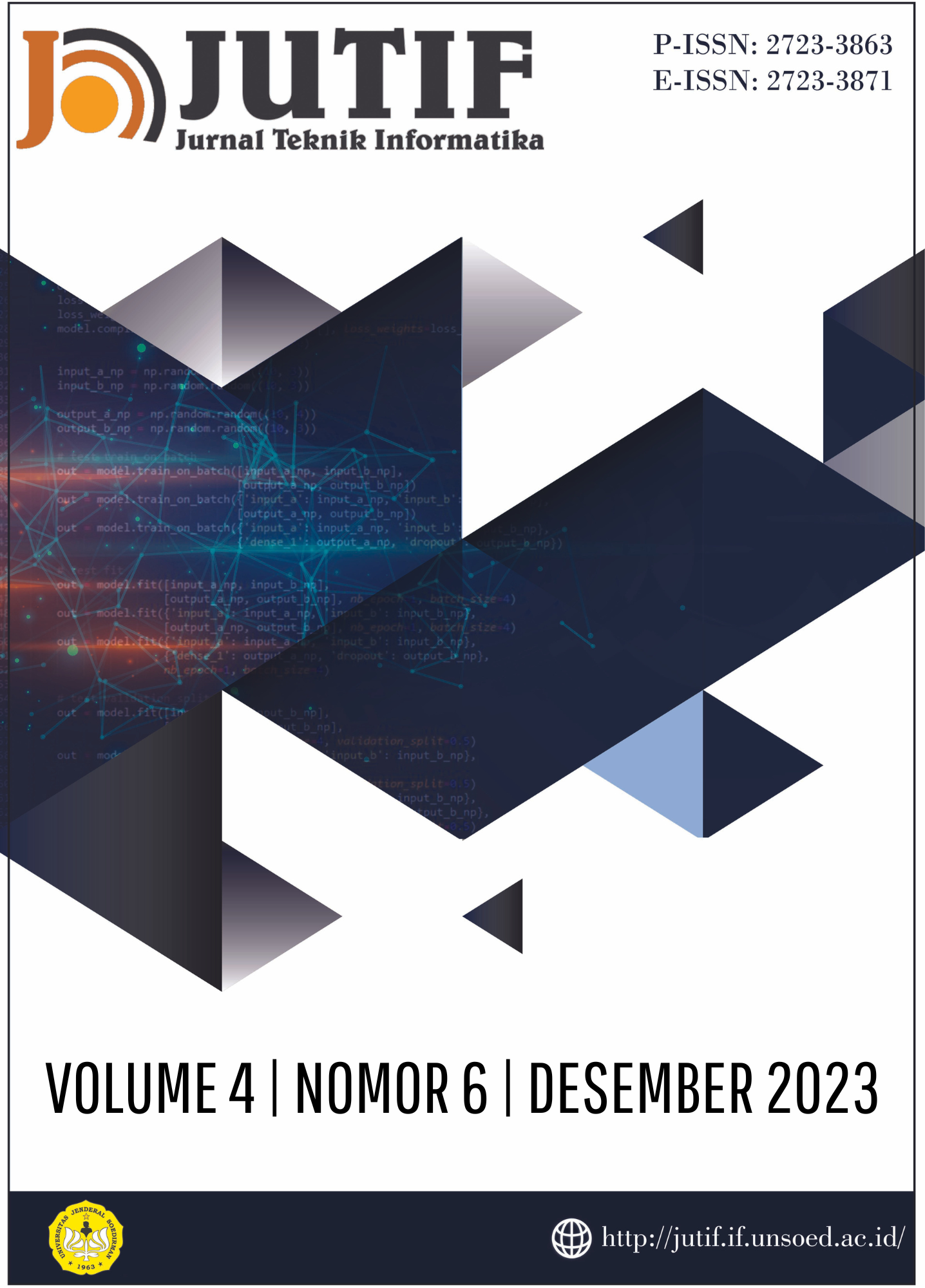TRANSFER LEARNING IMPLEMENTATION ON IMAGE RECOGNITION OF INDONESIAN TRADITIONAL HOUSES
DOI:
https://doi.org/10.52436/1.jutif.2023.4.6.767Keywords:
CNN, Indonesia, MobileNetV2, Traditional houses, transer learningAbstract
Indonesia is the largest archipelago in the world that has cultural diversity, one of Indonesia's cultural wealth is the architectural uniqueness of the types of traditional houses that come from different tribes and regions. in this era of digitalization, the younger generation of this nation must continue to preserve cultural wealth, one of which is by building a system that can document and provide learning about image recognition of the archipelago's traditional houses. Thanks to Artificial Intelligence Technology, it is possible to create a smart model that functions as an image recognition with system learning by working with a neural network called deep learning, which is supported by a transfer learning algorithm that can utilize previous models that have been trained, one of which is the MobileNetV2, Resnet50, VGG16 and Xception models as an effort to get a model with high accuracy with limited dataset conditions. So, the purpose as well as the update of this research is to build an image recognition model of Indonesian traditional houses with the transfer learning method. The methods and stages used are CRISP-DM (Cross Industry Standard Process for Data Mining), a standard used to build applications that aim to gain insight from a dataset, the image dataset used in this study was created with the image scraper technique from the internet. The conclusion of this research is that an image recognition model of Indonesian traditional houses is produced by training experiments from 5 transfer learning models that have been determined and the greatest accuracy is obtained, namely 0.96% of the MobileNetV2 transfer training method, the potential for further development for future research is to add more classes and amount of data and design a more detailed and detailed deployment model.
Downloads
References
G. Shobha and S. Rangaswamy, Machine Learning, 1st ed., vol. 38. Elsevier B.V., 2018. doi: 10.1016/bs.host.2018.07.004.
Francois Chollet, Deep Learning with Python, Second Edition, Second Ed. Manning Publications, 2021. Accessed: Oct. 26, 2022. [Online]. Available: https://www.manning.com/books/deep-learning-with-python-second-edition
U. Michelucci, Advanced Applied Deep Learning. 2019. doi: 10.1007/978-1-4842-4976-5.
A. F. Gad, Practical Computer Vision Applications Using Deep Learning with CNNs. 2018. doi: 10.1007/978-1-4842-4167-7.
H. Fujiyoshi, T. Hirakawa, and T. Yamashita, “Deep learning-based image recognition for autonomous driving,” IATSS Research, vol. 43, no. 4, pp. 244–252, 2019, doi: 10.1016/j.iatssr.2019.11.008.
S. Aldiansyah, “Mitigasi bencana melalui kearifan lokal,” Jurnal Masyarakat & Budaya, vol. 21, no. 18, pp. 9–12, 2021.
I. Poerwaningtias and N. K. Suwarto, Rumah Adat Nusantara, 1st ed., no. November 2018. Jakarta: Badan Pengembangan dan Pembinaan Bahasa, 2017. [Online]. Available: 1
E. I. Haksoro and A. Setiawan, “Pengenalan Jamur Yang Dapat Dikonsumsi Menggunakan Metode Transfer Learning Pada Convolutional Neural Network,” Jurnal ELTIKOM, vol. 5, no. 2, pp. 81–91, 2021, doi: 10.31961/eltikom.v5i2.428.
S. Aras, A. Setyanto, and U. D. Makassar, “Deep Learning Untuk Klasifikasi Motif Batik Papua Menggunakan EfficientNet dan Trasnfer Learning,” Insect, vol. 8, no. 1, pp. 11–20, 2022.
M. F. Naufal and S. F. Kusuma, “Pendeteksi Citra Masker Wajah Menggunakan CNN dan Transfer Learning,” Jurnal Teknologi Informasi dan Ilmu Komputer, vol. 8, no. 6, p. 1293, 2021, doi: 10.25126/jtiik.2021865201.
C. Schröer, F. Kruse, and J. M. Gómez, “A systematic literature review on applying CRISP-DM process model,” Procedia Comput Sci, vol. 181, no. 2019, pp. 526–534, 2021, doi: 10.1016/j.procs.2021.01.199.
Y. N. Fuadah, S. Saidah, N. K. Sy, R. Magdalena, and I. Da’wan Ubaidullah, “Glaucoma Classification Based on Fundus Images Processing With Convolutional Neural Network,” Jurnal Teknik Informatika (JUTIF), vol. 3, no. 3, pp. 717–722, 2022, [Online]. Available: https://doi.org/10.20884/1.jutif.2022.3.3.276
D. M. Thomas and S. Mathur, “Data Analysis by Web Scraping using Python,” in Proceedings of the 3rd International Conference on Electronics and Communication and Aerospace Technology, ICECA 2019, 2019. doi: 10.1109/ICECA.2019.8822022.
A. A. Ardakani, A. R. Kanafi, U. R. Acharya, N. Khadem, and A. Mohammadi, “Application of deep learning technique to manage COVID-19 in routine clinical practice using CT images: Results of 10 convolutional neural networks,” Comput Biol Med, vol. 121, no. April, p. 103795, 2020, doi: 10.1016/j.compbiomed.2020.103795.
M. Elpeltagy and H. Sallam, “Automatic prediction of COVID− 19 from chest images using modified ResNet50,” Multimed Tools Appl, vol. 80, no. 17, pp. 26451–26463, 2021, doi: 10.1007/s11042-021-10783-6.
S. Roopashree and J. Anitha, “DeepHerb: A Vision Based System for Medicinal Plants Using Xception Features,” IEEE Access, vol. 9, pp. 135927–135941, 2021, doi: 10.1109/ACCESS.2021.3116207.
P. Danielsson, T. Postema, and H. Munir, “Heroku-based innovative platform for web-based deployment in product development at axis,” IEEE Access, vol. 9, pp. 10805–10819, 2021, doi: 10.1109/ACCESS.2021.3050255.



























